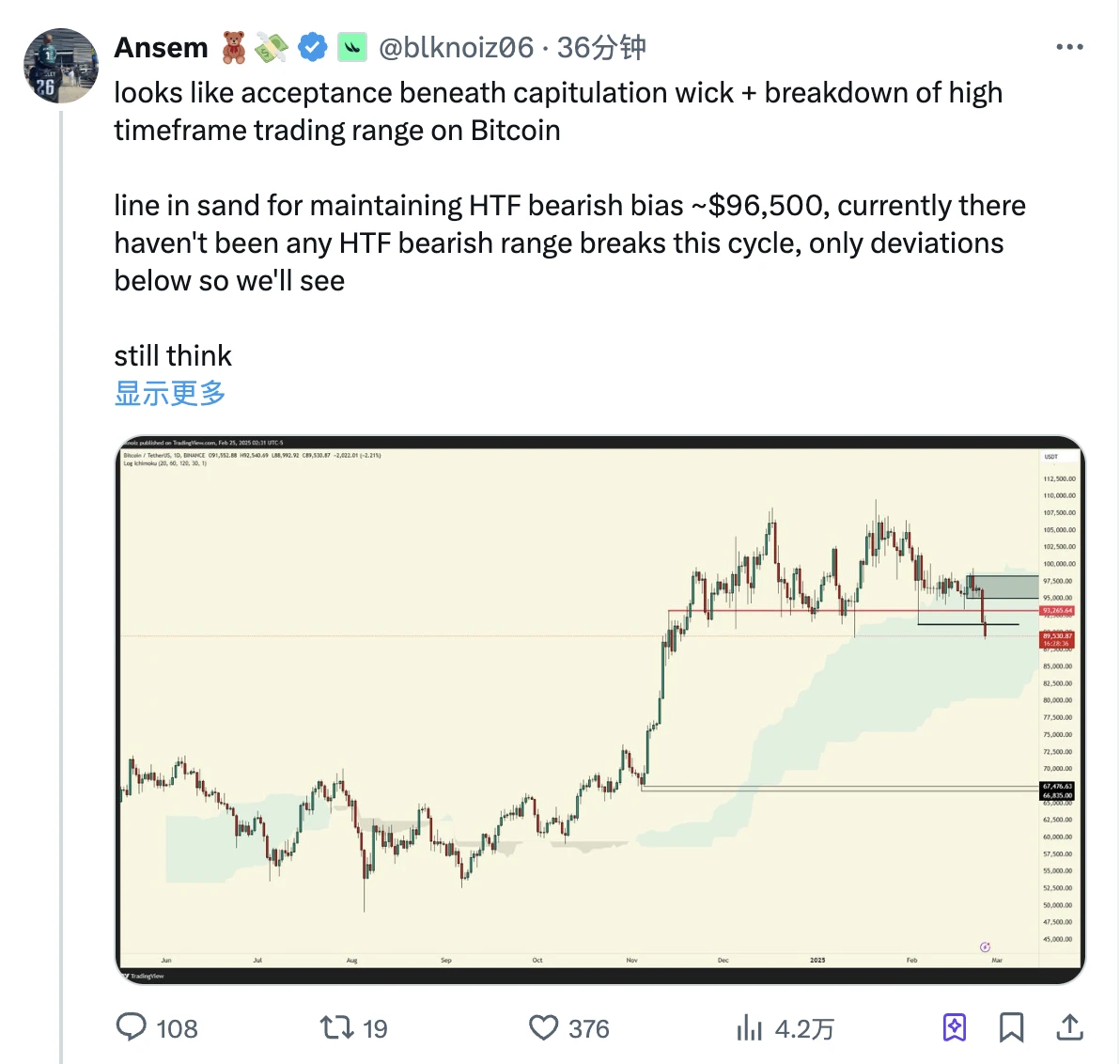Original | Odaily Planet Daily (@OdailyChina)
Author | Azuma (@azuma_eth)

This morning, we just published an article titled “Market Accelerates Downward, Is BTC Really Heading to 70,000?”. We thought we were mentally prepared for the market to continue declining, but we did not expect the new round of accelerated decline to come so quickly.
Around 15:30, BTC fell below the 90,000 USD mark for the first time in nearly a month and a half. OKX market data shows:
BTC briefly dropped to 88,189 USDT, and as of 15:50, it was reported at 89,204 USDT, a 24-hour decline of 6.80%;
ETH briefly fell to 2,315 USDT, currently reported at 2,378.01 USDT, a 24-hour decline of 12.5%;
SOL briefly dropped to 132.8 USDT, currently reported at 136.5 USDT, a 24-hour decline of 15.12%;
Other altcoins and on-chain memes do not need much mention, with declines generally exceeding 10% or even 20%.
In terms of derivatives data, Coinglass shows that in the past 24 hours, the total liquidation across the network reached 1.337 billion USD, with the vast majority being long liquidations, amounting to 1.25 billion USD. In terms of cryptocurrencies, BTC liquidations amounted to 517 million USD, and ETH liquidations were 294 million USD.

Targeting Contract Whales?
Regarding the cause of this sharp decline, some community members interpret it as a strong player targeting a certain whale who opened long BTC contracts on a CEX (nicknamed “Set 10 Big Targets First”).
Community screenshots show that this user had an average opening price of 100,320.8 USDT, with a position size of 5,184.527 BTC, and an estimated liquidation price of 82,592.68 USD.

However, as the market accelerated downward, this whale seems to have exited early. On-chain analyst Ai Yi monitored that this whale had cut losses on their long BTC contracts, selling 1,783.48 BTC at an average price of 89,138 USD in the past 5 minutes, totaling a value of 159 million USD.
Meanwhile, a user on X suspected to be this whale, jasonleo, also responded regarding this position. jasonleo admitted to “recognizing the mistake and exiting, giving back profits,” but clarified that they did not “lose money on the cut, the principal is still there,” as they entered the market later, causing the on-chain data platform to not account for previous profits.
The whale finally stated: “From a profit of 700 million to 0 profit, just one shot away from the 1 billion target, what a pity.”

What Do Various Big Shots/Institutions Think?
In this morning's article, we briefly covered the views of BitMEX co-founder Arthur Hayes and Placeholder partner Chris Burniske on the market outlook—Arthur Hayes remains bearish to 70,000 USD; Chris Burniske firmly believes this is just a pullback in a bull market.
To help everyone better assess the market outlook, we have compiled more opinions from big shots/institutions, detailed as follows.
OKX: Multiple Factors Trigger This Round of Decline, Key to Future Market Lies in Incremental Capital Inflows
Zhao Wei, a senior researcher at OKX Research Institute, analyzed this round of decline, stating that global trade tensions, a sharp drop in U.S. stocks, leveraged liquidations, institutional capital withdrawals, frequent security incidents, and the cooling of SOL ecosystem speculation have collectively driven this market downturn.
On a macro level, tightening liquidity continues to pressure risk assets. Expectations of interest rate hikes by the Bank of Japan have risen, with the yen breaking through the 149 mark against the dollar, directly impacting the largest carry trade vehicle globally. Meanwhile, the Nasdaq index has fallen over 4% for three consecutive days, with technology stock valuations declining, further affecting high-beta assets like Bitcoin. Additionally, a stronger dollar has pushed up risk-free yields, attracting funds back to low-risk assets, accelerating the outflow of high-risk assets.
In the crypto market, internal vulnerabilities have been amplified during this decline. First, the reversal of institutional capital flows has become a key pressure point. Recently, Bitcoin and Ethereum spot ETFs have seen continuous net outflows, with some institutional holding cost lines being breached, triggering programmatic selling. Secondly, in the derivatives market, large institutions have significantly reduced their Ethereum futures positions, indicating a shift in their market expectations. Furthermore, the SOL ecosystem is facing liquidity challenges, with on-chain Memecoin trading volumes declining, speculative funds withdrawing leading market makers to reduce quote depth, resulting in a surge in on-chain liquidation volumes and a decline in protocol revenues, potentially leading to a reconstruction of the SOL ecosystem's valuation model. The wave of leveraged liquidations has further exacerbated market turmoil, with some crypto asset prices breaking down, triggering cascading liquidations in DeFi. Meanwhile, recent security incidents have intensified the market's trust crisis, with users' concerns about asset security rising, further undermining confidence in the crypto market.
Future market trends will be influenced by both macro environments and internal factors, but the core still depends on the continuous inflow of incremental capital. However, the current global economic situation is unclear, with tariff pressures exacerbating the decline in risk appetite, and the recovery of the crypto market still needs to wait for institutional capital to flow back and new phenomenon-level applications to drive narrative reconstruction for a healthy market adjustment. Currently, the crypto market is under the triple pressure resonance of macro liquidity contraction, internal ecological adjustments, and exposure of market structural vulnerabilities. Users should focus on the industry's technological innovation cycle, the performance of U.S. tech stock earnings reports, and the pace of global central bank policy adjustments. Only when on-chain stablecoin inflows return to positive growth, futures positions hit a bottom and rebound, and major cryptocurrencies stabilize at the weekly level can the market repair cycle be confirmed.
Matrixport: High Likelihood of Continued Decline, Limited Buying Demand
Matrixport released a statement today regarding market fluctuations: “Bitcoin has broken below the ascending expanding wedge, although this is not what we hoped for, this pattern usually indicates downside risk unless the price can quickly rebound and return to within the wedge. The likelihood of further declines in Bitcoin is high, especially since this drop occurred during a period of low trading activity, with limited demand for buying on dips.”
“While we expect prices to have room for growth in the second half of this year, this technical breakdown has made market sentiment more cautious. Moreover, not only Bitcoin has broken down, but Ethereum has also fallen below the key support range of 2,600 to 2,800 USD.”
Raoul Pal: Just a Pullback, Learn to Filter Out Noise
Raoul Pal, co-founder and CEO of Real Vision, commented on the decline: “Be patient. The current market structure is very similar to 2017. BTC has experienced five pullbacks greater than 28%, lasting 2-3 months before reaching new highs, while altcoins generally fell over 65%. The market is full of noise; do something more meaningful than just watching the screen.”
Ansem: Focus on the Recovery of 96,500, Beware of Subsequent Stock Market Declines
Well-known trader Ansem stated on X that the key point to watch next is whether BTC can recover around the 96,500 level, but the more significant issue is that if cryptocurrencies are preemptively reflecting the risk-averse trend of the entire market, and if stock indices also collapse in the coming weeks, then this is more likely the beginning of a downward trend rather than a small episode in an upward trend.

CoinDesk Analyst: Nasdaq Decline + Japanese Rate Hike Triggered the Crash
Omkar Godbole, editor of CoinDesk's market analysis team, released a market analysis stating that expectations of interest rate hikes by the Bank of Japan and the decline in Nasdaq futures led to this round of crash in the crypto market. Market data shows that Nasdaq futures fell by 0.3%, indicating that the trend of declines over three consecutive days will continue, with the tech stock index down over 4% since February 18.
The safe-haven currency yen against the dollar is at 149.38, likely to challenge the nearly three-month high of 148.84 set on Monday. As the market bets on the Bank of Japan raising interest rates, the yen has risen nearly 6% in six weeks. The comments on interest rate hikes by the Bank of Japan and the strengthening yen evoke memories of last July: at that time, due to the central bank's interest rate hikes, the yen soared, ultimately triggering widespread risk-averse sentiment, causing Bitcoin to plummet from about 65,000 USD to 50,000 USD within days.
免责声明:本文章仅代表作者个人观点,不代表本平台的立场和观点。本文章仅供信息分享,不构成对任何人的任何投资建议。用户与作者之间的任何争议,与本平台无关。如网页中刊载的文章或图片涉及侵权,请提供相关的权利证明和身份证明发送邮件到support@aicoin.com,本平台相关工作人员将会进行核查。



